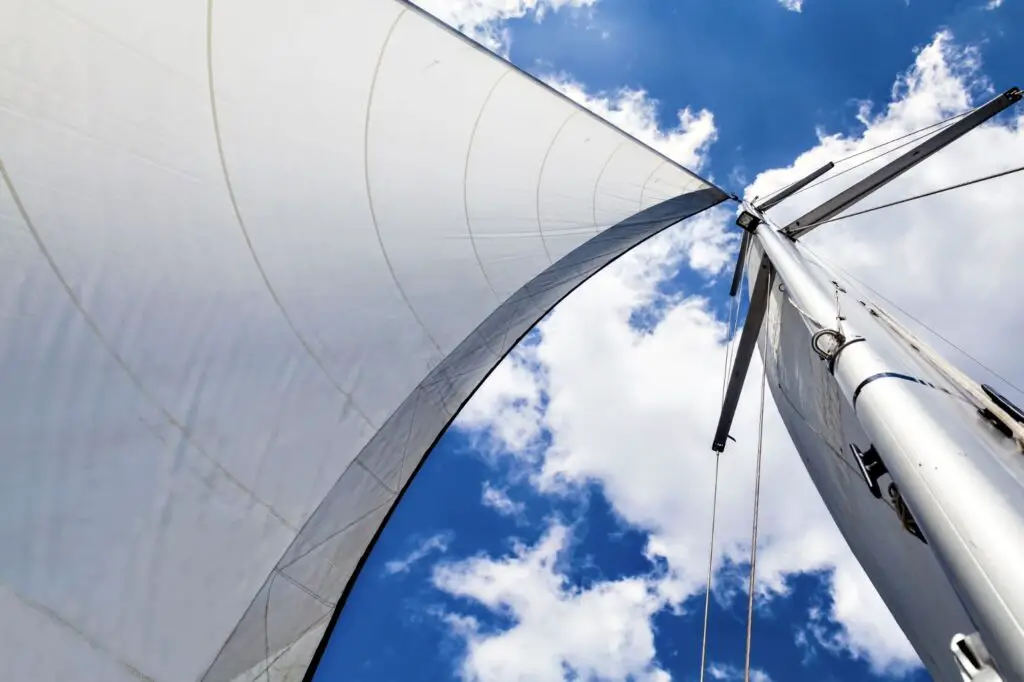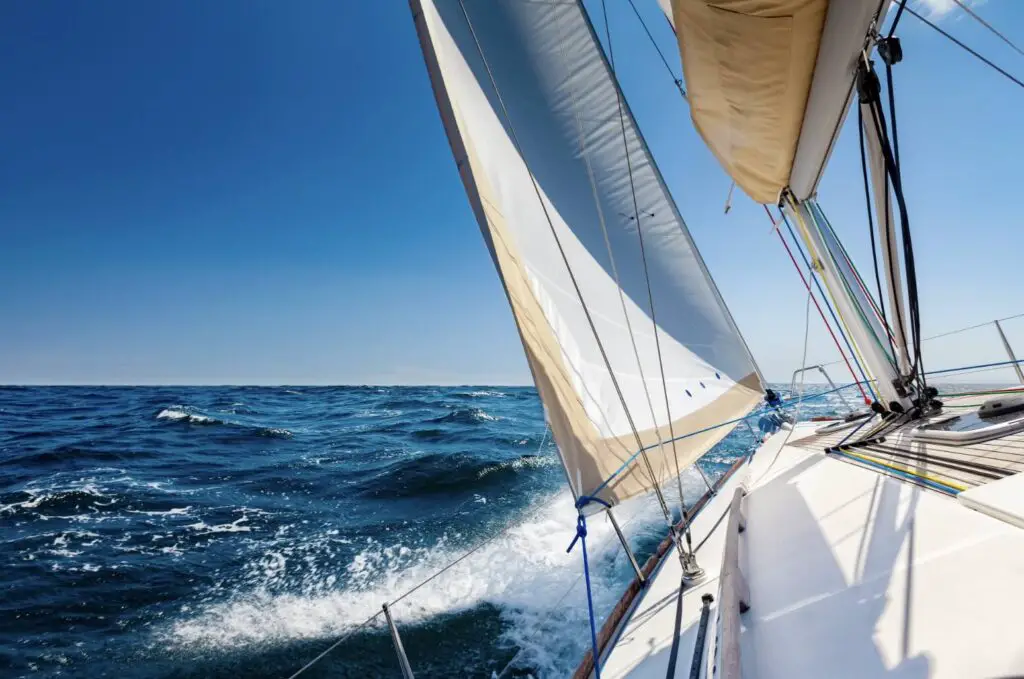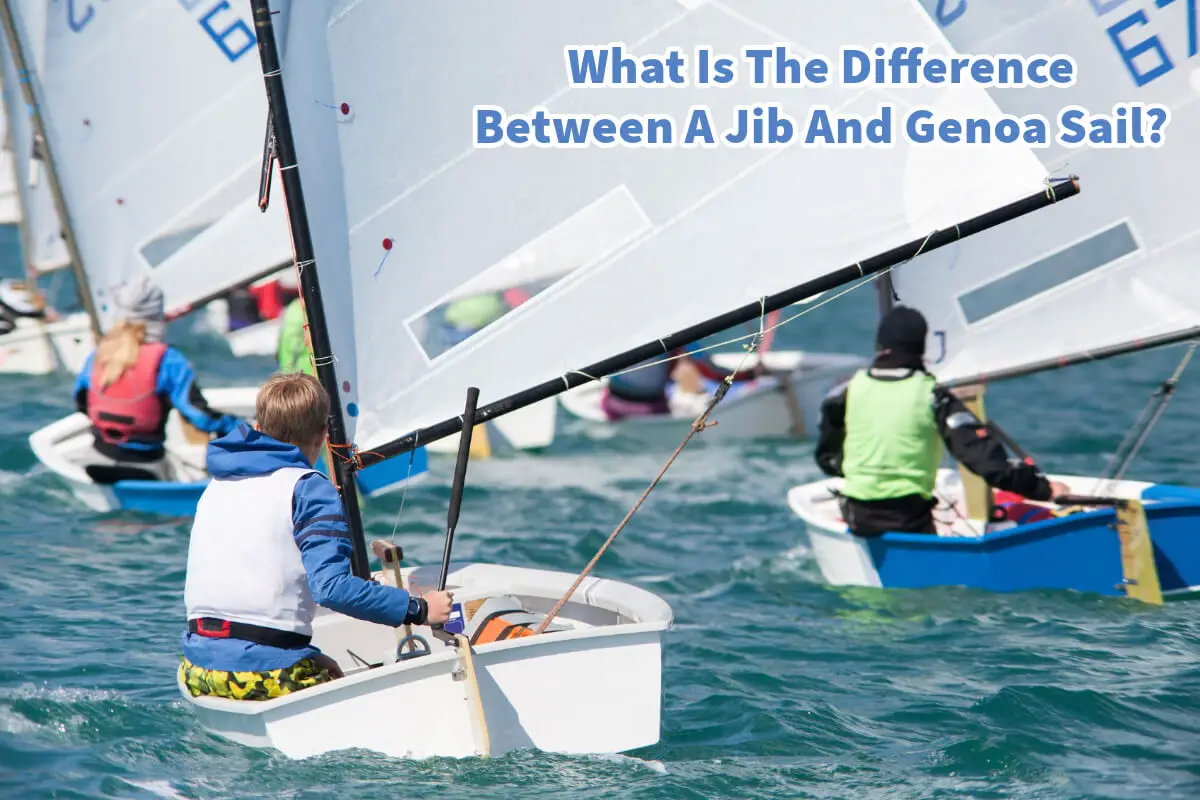Whenever I go sailing, I’m always amazed by the sheer number of terms related to sails and sailing. It’s fascinating how these terms are integral to learning the ropes of this sport. Like many other sports, sailing is far more complex than it might initially seem.
For example, when most people think about sails, they picture the main and jib sails. However, many don’t realize that there are two main types of jib sails: the genoa and the jib. Even though many sailors use these terms interchangeably, they are not the same and serve different purposes. This distinction is just one of the many intricacies that make sailing a rich and rewarding experience.
Table of Contents
- What Is A Jib Sail On A Sailboat?
- What Is A Genoa Sail On A Sailboat?
- Understanding The Difference Between A Jib Sail And A Genoa Sail
- Related Questions
What Is A Jib Sail On A Sailboat?
A jib is a triangular sail that is set ahead of the foremast of a sailing vessel. The forward corner, the tack, is fixed to the bowsprit, the bow, or the deck between the bowsprit and the foremost mast.

Detailed Definitions Of Jib Sail
Here are some aspects of the jib sail that make it an essential part of a sailboat.
- Triangular Sail: The jib is distinctively triangular, which allows it to catch the wind and propel the boat forward effectively. Its shape and placement also help maneuver and balance the sailboat.
- Positioning: The jib’s forward corner (tack) is typically fixed at the bowsprit, a spar extending from the vessel’s bow, or directly at the bow or the deck. This positioning allows the jib to work harmoniously with the mainsail, improving the boat’s aerodynamics and efficiency.

Importance Of The Jib Sail
- Improved Maneuverability: The jib is crucial in steering and maneuvering the sailboat. By adjusting the jib, sailors can change the boat’s direction more precisely, especially when tacking or jibing.
- Enhanced Speed: The jib works with the mainsail to increase the sailboat’s speed. It helps create additional forward thrust, making the vessel faster and more efficient in various wind conditions. A sailboat will sail faster and smoother with both the primary and jib sail.
- Balance And Stability: The jib contributes to the overall balance of the sailboat. When properly trimmed, it helps to counterbalance the force of the wind on the mainsail, maintaining the vessel’s stability.
My Personal Experience
I have come to appreciate the jib’s versatility and importance in my sailing adventures. Understanding how to use the jib effectively has significantly impacted my sailing experience. The jib has ensured smooth and controlled sailing, whether navigating through calm waters or braving rough waters.
Knowing the jib and its functions is essential for those looking to get into sailing or enhance their skills. It improves your sailing technique and enhances your appreciation for the intricacies of this beautiful sport.
What Is A Genoa Sail On A Sailboat?
The Genoa sail, often referred to simply as a “genoa,” is a specific type of jib sail larger than the standard jib. While many people might casually call it a jib, the Genoa is distinguished by its size and how it overlaps the mainsail.
This sail extends past the mast, offering a larger sail area that can significantly impact the boat’s performance, especially in light to moderate wind conditions.

Detailed Definition
Here are some specific aspects of a genoa sail that make it unique.
- Size and Shape: The Genoa is a large, overlapping jib sail. It is typically much bigger than a standard jib and can extend beyond the mast, covering a substantial portion of the mainsail. This overlap increases the sail area, allowing the boat to harness more wind power.
- Types of Genoas: There are several kinds of Genoa sails, categorized by their size relative to the foretriangle (the triangular area formed by the mast, deck, and forestay). Common sizes include:
- Light Genoa (150%): Ideal for very light wind conditions.
- Medium Genoa (130%-140%): Used in moderate wind conditions.
- Heavy Genoa (110%-120%): Suitable for stronger winds while providing overlap.
When To Use A Genoa
The Genoa is most effective in light to moderate wind conditions. Here’s why and how it is used in different scenarios:
- Light Wind Conditions: In light winds, the Genoa’s large sail area helps maximize the boat’s speed by capturing more wind. This is crucial for maintaining momentum when the wind is minimal, and it can also help propel a boat forward.
- Moderate Wind Conditions: A medium-sized Genoa is perfect for moderate winds, balancing power and control. It helps in optimizing performance without overwhelming the boat’s handling.
- Heavy Wind Conditions: A smaller Genoa (or switching to a standard jib) is advisable in stronger winds. The reduced sail area helps maintain control and stability, preventing excessive heeling and potential capsizing.
Importance Of The Genoa In Sailing
- Enhanced Performance: Genoa’s larger sail area provides significant power, enhancing the boat’s speed and efficiency, especially when sailing upwind.
- Versatility: The availability of different sizes allows sailors to choose the appropriate Genoa based on the prevailing wind conditions, ensuring optimal performance across a range of scenarios.
- Improved Balance and Handling: When used correctly, the Genoa can improve the boat’s balance and handling, making it easier to steer and maneuver.
- Critical for Racing: In competitive sailing, the Genoa is crucial for gaining an edge. Its ability to harness more wind can make a significant difference in a race.
My Personal Experience
From my own sailing experiences, I’ve found that sailing in light wind can be a problem, especially if you are sailing a sailboat without a motor. In cases like this, you need a sail that can help you maximize your wind potential.
In light wind, the Genoa can dramatically change the boat’s dynamics. Switching to a larger Genoa has often been the key to maintaining speed and control when the wind is light. Understanding the nuances of different Genoa sizes and their best use cases has improved my sailing skills and enjoyment of the water.
The Genoa sail is an indispensable part of a sailor’s toolkit, offering flexibility and enhanced performance under various conditions. Knowing how to use a Genoa effectively can make all the difference, whether cruising or racing.
Understanding The Difference Between A Jib Sail And A Genoa Sail

The main difference between a jib sail and a genoa sail is their size and positioning relative to the mast.
A jib sail is a smaller, triangular sail set ahead of the foremast, typically extending only as far as the mast. In contrast, a genoa sail is a more significant type of jib that overlaps the mainsail and extends past the mast, providing a greater sail area.
Below is a summary of the critical differences in size, overlap, usage, and performance.
Key Differences Jib Vs. Genoa Sail
1. Size and Overlap:
- Jib Sail: Smaller and does not overlap the mainsail.
- Genoa Sail: Larger and overlaps the mainsail, often extending beyond the mast.
2. Usage:
- Jib Sail: Ideal for heavier wind conditions and provides better control and stability.
- Genoa Sail: Best used in light to moderate winds to maximize speed and efficiency due to its larger sail area.
3. Performance:
- Jib Sail: Offers more precise maneuvering and is easier to handle in various wind conditions.
- Genoa Sail: Enhances the boat’s performance in lighter winds by increasing the effective sail area, which captures more wind.
Importance For Sailors
Understanding the differences between a jib and a genoa is crucial for sailors because it allows them to optimize their sail configuration based on the prevailing wind conditions. By selecting the appropriate sail, sailors can improve their boat’s performance, ensure safer handling, and make informed decisions during their voyages.
Choosing between a jib and a genoa can significantly impact sailing efficiency and safety. Mastering both sails enables sailors to adapt to changing weather conditions and enhance their overall sailing experience.
At A Bus On A Dusty Road, we talk about travel, life, sailing, and ex-pat living. We are all about “Living Life As A Global Citizen.” We explore sailing, social, cultural, and economic issues, and travel.
We would love to have you be part of our community. Sign up for our newsletter to keep up-to-date by clicking here. If you have any questions, you can contact me, Anita, by clicking here.
Listen to our Podcast called Dusty Roads. You can find it on all major podcast platforms. Try out listening to one of our podcasts by clicking here.
Subscribe to our A Bus On A Dusty Road YouTube Channel with great videos and information by clicking here.
Related Questions
What Is Jibing In Sailing? Steps To A Proper Controlled Jibe
A jibe in sailing is when the boat moves with the stern through the wind. In a jibe, the stern will move through the wind. Like any sailing maneuver, when you have a crew, the helmsman or the captain steering the boat needs to adequately communicate with the crew about what is happening so that they know; this is especially true when jibing.
By clicking here, you can discover What Is Jibing In Sailing? Steps To A Proper Controlled Jibe.
What Is Tacking In Sailing? Steps To A Proper Tack
Tacking is when you move the boat’s bow into the wind to turn the boat’s direction. It is a very common maneuver that all sailors must learn to master. But with any sailing maneuver, there are proper steps; you must know to do a good and safe tack.
By clicking here, you can discover What Is Tacking In Sailing? Steps To A Proper Tack
What Is The Sailing Term For “No Wind”?
The term calm or becalm is used to describe sailing with no wind. In ancient times, the sailors also used the word Tide Over to indicate that there was no wind, so they were Tide Over or stuck without being able to sail.
By clicking here, you can discover What Is The Sailing Term For “No Wind”?

